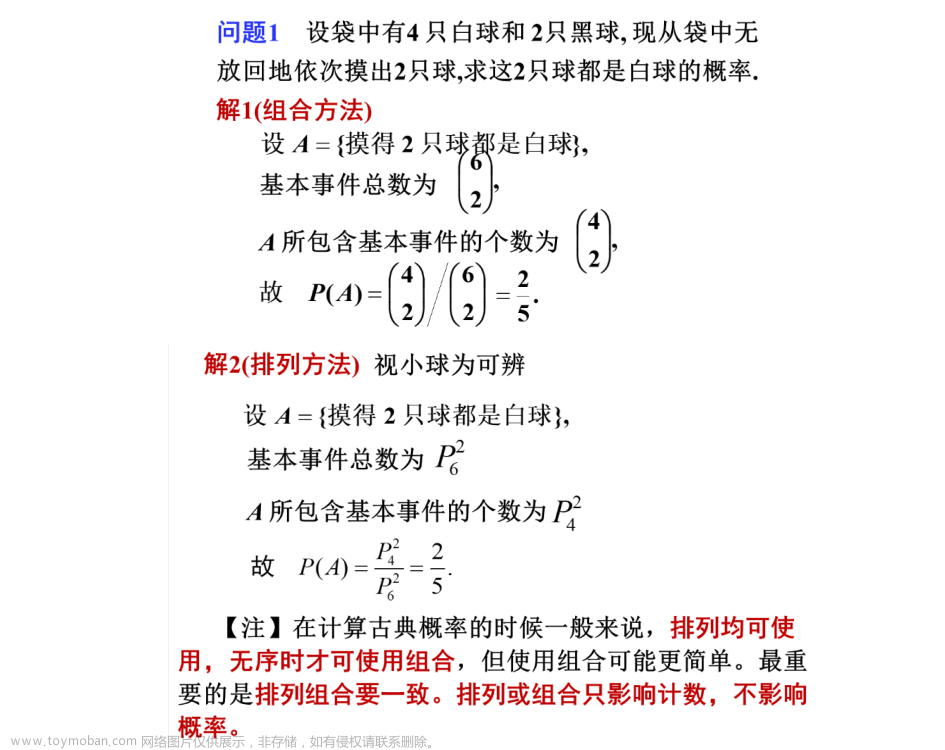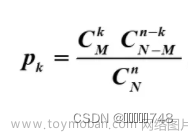第四章 基于概率论的分类方法:朴素贝叶斯
4.1基于贝叶斯理论的分类方法
朴素贝叶斯
- 优点:在数据较少的情况下仍然有效,可以处理多类别问题。
- 缺点:对于输⼊数据的准备⽅式较为敏感。
适⽤数据类型:标称型数据。
假设类别为 c 1 , c 2 c_1,c_2 c1,c2:
- 如果 p 1 ( x , y ) > p 2 ( x , y ) p1(x,y) > p2(x,y) p1(x,y)>p2(x,y),那么类别为 c 1 c_1 c1
- 如果 p 2 ( x , y ) > p 1 ( x , y ) p2(x,y) > p1(x,y) p2(x,y)>p1(x,y),那么类别为 c 2 c_2 c2
4.2条件概率
p ( c ∣ x ) = p ( x ∣ c ) p ( c ) p ( x ) p(c|x)=\frac{p(x|c)p(c)}{p(x)} p(c∣x)=p(x)p(x∣c)p(c)
4.3使用条件概率来分类
假设类别为 c 1 , c 2 c_1,c_2 c1,c2:
- 如果 p 1 ( c 1 ∣ x , y ) > p 2 ( c 2 ∣ x , y ) p1(c_1|x,y) > p2(c_2|x,y) p1(c1∣x,y)>p2(c2∣x,y),那么类别为 c 1 c_1 c1
- 如果 p 2 ( c 1 ∣ x , y ) > p 1 ( c 2 ∣ x , y ) p2(c_1|x,y) > p1(c_2|x,y) p2(c1∣x,y)>p1(c2∣x,y),那么类别为 c 2 c_2 c2
4.5使用python进行文本分类
4.5.1准备数据
def loadDataSet():
postingList = [['my', 'dog', 'has', 'flea', 'problems', 'help', 'please'],
['maybe', 'not', 'take', 'him', 'to', 'dog', 'park', 'stupid'],
['my', 'dalmation', 'is', 'so', 'cute', 'I', 'love', 'him'],
['stop', 'posting', 'stupid', 'worthless', 'garbage'],
['mr', 'licks', 'ate', 'my', 'steak', 'how', 'to', 'stop', 'him'],
['quit', 'buying', 'worthless', 'dog', 'food', 'stupid']]
classVec = [0, 1, 0, 1, 0, 1] #1 is abusive, 0 not
return postingList, classVec
def createVocabList(dataSet):
vocabSet = set([]) #create empty set
for document in dataSet:
vocabSet = vocabSet | set(document) #union of the two sets
return list(vocabSet)
postingList, classVec=loadDataSet()
print(postingList)
print(classVec)
vocabList=createVocabList(postingList)
print(vocabList)
[['my', 'dog', 'has', 'flea', 'problems', 'help', 'please'], ['maybe', 'not', 'take', 'him', 'to', 'dog', 'park', 'stupid'], ['my', 'dalmation', 'is', 'so', 'cute', 'I', 'love', 'him'], ['stop', 'posting', 'stupid', 'worthless', 'garbage'], ['mr', 'licks', 'ate', 'my', 'steak', 'how', 'to', 'stop', 'him'], ['quit', 'buying', 'worthless', 'dog', 'food', 'stupid']]
[0, 1, 0, 1, 0, 1]
['to', 'licks', 'food', 'I', 'park', 'quit', 'how', 'maybe', 'is', 'has', 'him', 'garbage', 'buying', 'help', 'not', 'flea', 'so', 'problems', 'stupid', 'worthless', 'dog', 'ate', 'please', 'love', 'my', 'posting', 'stop', 'steak', 'cute', 'mr', 'dalmation', 'take']
loadDataSet产生数据集,表示若干句子,句子中若干单词
createVocabList对数据集进行操作,最后返回postingList和classVec
postingList为单词表,即数据集中出现的所有单词vocabList=[‘has’, ‘please’, ‘I’,…,‘dalmation’, ‘licks’]
classVec,表示每个句子是否含有侮辱性,是则为1,classVec=[0, 1, 0, 1, 0, 1]
4.5.2训练算法
def setOfWords2Vec(vocabList, inputSet):
returnVec = [0]*len(vocabList)
for word in inputSet:
returnVec[vocabList.index(word)] = 1
return returnVec
print(setOfWords2Vec(vocabList,postingList[0]))
[0, 0, 0, 0, 0, 0, 0, 0, 0, 1, 0, 0, 0, 1, 0, 1, 0, 1, 0, 0, 1, 0, 1, 0, 1, 0, 0, 0, 0, 0, 0, 0]
setOfWords2Vec函数,返回长度为单词表长度的向量
输入是,单词表vocabList和句子inputSet
inputSet中出现的单词,单词表对应位置的向量位置标记为1
def getTrainMatrix(vocabList,inputSets):
return [setOfWords2Vec(vocabList, inputSet) for inputSet in inputSets]
trainMatrix=getTrainMatrix(vocabList,postingList)
print(trainMatrix)
[[0, 0, 0, 0, 0, 0, 0, 0, 0, 1, 0, 0, 0, 1, 0, 1, 0, 1, 0, 0, 1, 0, 1, 0, 1, 0, 0, 0, 0, 0, 0, 0],
[1, 0, 0, 0, 1, 0, 0, 1, 0, 0, 1, 0, 0, 0, 1, 0, 0, 0, 1, 0, 1, 0, 0, 0, 0, 0, 0, 0, 0, 0, 0, 1],
[0, 0, 0, 1, 0, 0, 0, 0, 1, 0, 1, 0, 0, 0, 0, 0, 1, 0, 0, 0, 0, 0, 0, 1, 1, 0, 0, 0, 1, 0, 1, 0],
[0, 0, 0, 0, 0, 0, 0, 0, 0, 0, 0, 1, 0, 0, 0, 0, 0, 0, 1, 1, 0, 0, 0, 0, 0, 1, 1, 0, 0, 0, 0, 0],
[1, 1, 0, 0, 0, 0, 1, 0, 0, 0, 1, 0, 0, 0, 0, 0, 0, 0, 0, 0, 0, 1, 0, 0, 1, 0, 1, 1, 0, 1, 0, 0],
[0, 0, 1, 0, 0, 1, 0, 0, 0, 0, 0, 0, 1, 0, 0, 0, 0, 0, 1, 1, 1, 0, 0, 0, 0, 0, 0, 0, 0, 0, 0, 0]]
getTrainMatrix将若干句子全部转成向量、向量组成列表,这就成了一个矩阵trainMatrix。
import numpy as np
def trainNB0(trainMatrix, trainCategory):
numTrainDocs = len(trainMatrix)
numWords = len(trainMatrix[0])
pAbusive = sum(trainCategory)/numTrainDocs
# print('trainCategory: ',trainCategory)
# print('numTrainDocs: ',numTrainDocs)
p0Num = np.ones(numWords); p1Num = np.ones(numWords) #change to np.ones()
p0Denom = 0; p1Denom = 0 #change to 2.0
for i in range(numTrainDocs):
if trainCategory[i] == 1:
p1Num += trainMatrix[i]
p1Denom += sum(trainMatrix[i])
else:
p0Num += trainMatrix[i]
p0Denom += sum(trainMatrix[i])
# p1Vect = np.log(p1Num/p1Denom) #change to np.log()
# p0Vect = np.log(p0Num/p0Denom) #change to np.log()
p1Vect = p1Num/p1Denom
p0Vect = p0Num/p0Denom
print(p1Num)
print(p1Denom)
return p0Vect, p1Vect, pAbusive
print(classVec)
p0Vect, p1Vect, pAbusive=trainNB0(trainMatrix,classVec)
print(p0Vect)
print(p1Vect)
print(pAbusive)
[0, 1, 0, 1, 0, 1]
[2. 1. 2. 1. 2. 2. 1. 2. 1. 1. 2. 2. 2. 1. 2. 1. 1. 1. 4. 3. 3. 1. 1. 1.
1. 2. 2. 1. 1. 1. 1. 2.]
19
[0.08333333 0.08333333 0.04166667 0.08333333 0.04166667 0.04166667
0.08333333 0.04166667 0.08333333 0.08333333 0.125 0.04166667
0.04166667 0.08333333 0.04166667 0.08333333 0.08333333 0.08333333
0.04166667 0.04166667 0.08333333 0.08333333 0.08333333 0.08333333
0.16666667 0.04166667 0.08333333 0.08333333 0.08333333 0.08333333
0.08333333 0.04166667]
[0.10526316 0.05263158 0.10526316 0.05263158 0.10526316 0.10526316
0.05263158 0.10526316 0.05263158 0.05263158 0.10526316 0.10526316
0.10526316 0.05263158 0.10526316 0.05263158 0.05263158 0.05263158
0.21052632 0.15789474 0.15789474 0.05263158 0.05263158 0.05263158
0.05263158 0.10526316 0.10526316 0.05263158 0.05263158 0.05263158
0.05263158 0.10526316]
0.5
开始算条件概率,如计算侮辱性的条件概率p1Vect,那么就该词侮辱性次数/侮辱总次数:p1Num/p1Denom
p1Num=[2. 1. 2. 1. … 4. 3. 3. 1. 1. 2.],p1Denom=19
p1Vect=[0.10526316 … 0.05263158 0.10526316]文章来源:https://www.toymoban.com/news/detail-534878.html
4.5.3测试算法
def classifyNB(vec2Classify, p0Vec, p1Vec, pClass1):
p1 = sum(vec2Classify * p1Vec)
p0 = sum(vec2Classify * p0Vec)
# print('p1:',p1,', p0:',p0)
if p1 > p0:
return 1
else:
return 0
def testingNB():
p0V, p1V, pAb = trainNB0(trainMatrix, classVec)
testEntrys = [['love', 'my', 'dalmation'],['stupid', 'garbage']]
for testEntry in testEntrys:
thisDoc = setOfWords2Vec(myVocabList, testEntry)
print(testEntry, 'classified as: ', classifyNB(thisDoc, p0V, p1V, pAb))
# print('thisDoc:',thisDoc)
# print('p0V:',p0V)
# print('p1V:',p1V)
testingNB()
['love', 'my', 'dalmation'] classified as: 0
['stupid', 'garbage'] classified as: 1
可以看出,经过小数据集训练,朴素贝叶斯模型可对简单的句子可以进行正确分类文章来源地址https://www.toymoban.com/news/detail-534878.html
到了这里,关于第四章 基于概率论的分类方法:朴素贝叶斯的文章就介绍完了。如果您还想了解更多内容,请在右上角搜索TOY模板网以前的文章或继续浏览下面的相关文章,希望大家以后多多支持TOY模板网!









